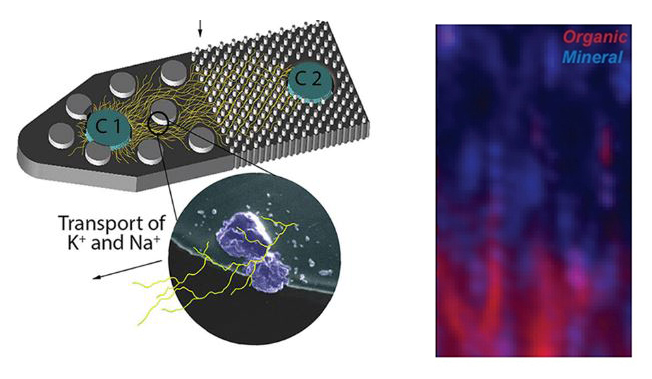Direct Visualization of Fungal Mineral Transport
11/17/2022

Schematic of a mineral-doped micromodel for investigating mineral-microbe interactions (left). X-ray fluorescence map of potassium bound to minerals (right, purple) on the micromodel platform and bound to fungal hyphae (right, red) grown on the platform. [Reprinted under a Creative Commons Attribution License 4.0 (CC BY 4.0) from A. Bhattacharjee et al. 2022. DOI: 10.1128/msystems.00913-22]
The Science
Soil fungi facilitate translocation of inorganic nutrients from soil minerals to other microorganisms and plants. This ability is particularly advantageous in impoverished soils because fungal mycelial networks can bridge otherwise spatially disconnected and inaccessible nutrient hotspots. However, the molecular mechanisms underlying fungal mineral weathering and transport through soil remains poorly understood. This is primarily due to the lack of a platform for spatially resolved analysis of biotic-driven mineral weathering. Scientists addressed this knowledge gap by developing a mineral-doped soil micromodel platform to study mineral weathering mechanisms. The platform demonstrates fungal bridging of carbon hotspots and hyphal transport of mineral-derived nutrients.
The Impact
Fungal species are foundational members of soil microbiomes, where their contributions in accessing and transporting vital nutrients is key to community resilience. The newly developed mineral-doped soil micromodel platform directly probes fungal growth using spatially resolved optical and chemical imaging methodologies. Results demonstrate that mineral presence is required for fungal thigmotropism—the turning or bending of an organism in response to contact with an object—around obstacles and through soil-like pore spaces. This is related to fungal transport of potassium and corresponding speciation from potassium-rich minerals. The findings provide visual mechanistic evidence of hyphal transport of mineral-derived nutrients under nutrient and water stresses.
The Summary
Researchers used X-ray fluorescence (XRF) imaging and X-ray absorption near edge structure (XANES) spectroscopy at the Stanford Synchrotron Radiation Lightsource (SSRL) beamline 14-3 to measure potassium uptake in fungal hyphae. Specifically, they measured how organic acids exuded from Fusarium sp. Strain DS 682, a representative common saprotrophic soil fungus, chelate and uptake potassium from mineral interfaces. The measurements were complemented using mass spectrometry imaging techniques at the Environmental Molecular Sciences Laboratory (EMSL).
Related Links
- BER Resource: Structural Molecular Biology Resource
- Environmental Molecular Sciences Laboratory (EMSL)
References
Bhattacharjee et al. 2022. A Mineral-Doped Micromodel Platform Demonstrates Fungal Bridging of Carbon Hot Spots and Hyphal Transport of Mineral-Derived Nutrients. Mycology 7 (6). [DOI: 10.1128/msystems.00913-22]
